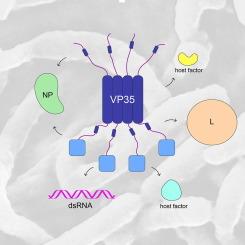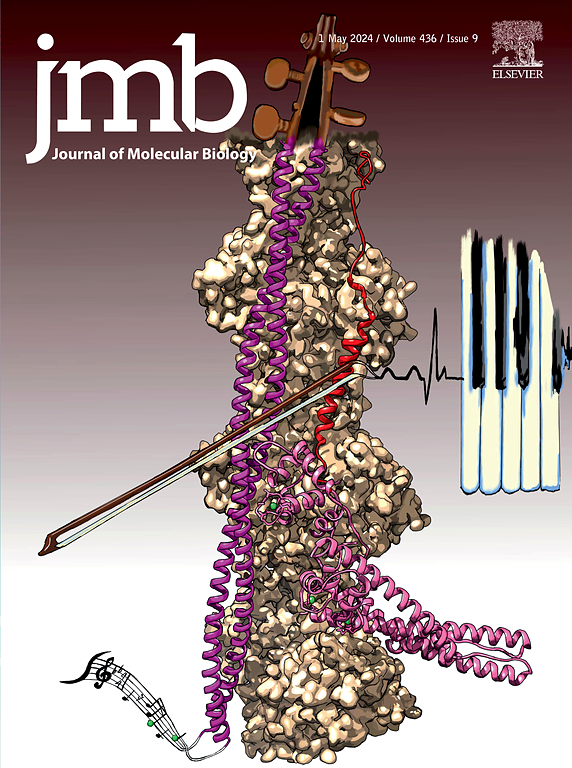25 Years of Ebola Virus VP35 Research
IF 4.5
2区 生物学
Q1 BIOCHEMISTRY & MOLECULAR BIOLOGY
引用次数: 0
Abstract
Ebola virus (EBOV) is a highly virulent non-segmented, negative-sense RNA virus and a causative agent of severe, often fatal disease in humans. EBOV encodes 7 genes and viral protein 35 (VP35) plays a key role in EBOV pathogenesis. VP35 is an EBOV polymerase cofactor that facilitates host immune evasion, viral RNA synthesis, and nucleocapsid assembly. Over the past 25 years since the first recognition that VP35 can antagonize innate immune responses, considerable progress has been made to define the molecular mechanisms by which VP35 mediates its multiple functions and interactions with host factors. Much of this work is based on our understanding of the VP35 sequence and structure as it relates to function. Here, we will provide a comprehensive review of the VP35 structure and known insights into function. Given its significant role, VP35 has also emerged as a therapeutic target for the development of countermeasures against EBOV.

埃博拉病毒VP35研究25年。
埃博拉病毒(EBOV)是一种高毒力的非节段性负义RNA病毒,是人类严重且往往致命疾病的病原体。EBOV编码7个基因,病毒蛋白35 (VP35)在EBOV发病中起关键作用。VP35是一种EBOV聚合酶辅助因子,促进宿主免疫逃避、病毒RNA合成和核衣壳组装。在过去的25年里,自首次认识到VP35可以拮抗先天免疫反应以来,在确定VP35介导其多种功能和与宿主因子相互作用的分子机制方面取得了相当大的进展。这项工作的大部分是基于我们对VP35序列和结构的理解,因为它与功能有关。在这里,我们将全面回顾VP35的结构和已知的功能。鉴于其重要作用,VP35也成为开发对策的治疗靶点。
本文章由计算机程序翻译,如有差异,请以英文原文为准。
求助全文
约1分钟内获得全文
求助全文
来源期刊

Journal of Molecular Biology
生物-生化与分子生物学
CiteScore
11.30
自引率
1.80%
发文量
412
审稿时长
28 days
期刊介绍:
Journal of Molecular Biology (JMB) provides high quality, comprehensive and broad coverage in all areas of molecular biology. The journal publishes original scientific research papers that provide mechanistic and functional insights and report a significant advance to the field. The journal encourages the submission of multidisciplinary studies that use complementary experimental and computational approaches to address challenging biological questions.
Research areas include but are not limited to: Biomolecular interactions, signaling networks, systems biology; Cell cycle, cell growth, cell differentiation; Cell death, autophagy; Cell signaling and regulation; Chemical biology; Computational biology, in combination with experimental studies; DNA replication, repair, and recombination; Development, regenerative biology, mechanistic and functional studies of stem cells; Epigenetics, chromatin structure and function; Gene expression; Membrane processes, cell surface proteins and cell-cell interactions; Methodological advances, both experimental and theoretical, including databases; Microbiology, virology, and interactions with the host or environment; Microbiota mechanistic and functional studies; Nuclear organization; Post-translational modifications, proteomics; Processing and function of biologically important macromolecules and complexes; Molecular basis of disease; RNA processing, structure and functions of non-coding RNAs, transcription; Sorting, spatiotemporal organization, trafficking; Structural biology; Synthetic biology; Translation, protein folding, chaperones, protein degradation and quality control.
 求助内容:
求助内容: 应助结果提醒方式:
应助结果提醒方式:


